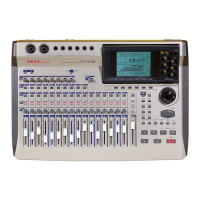
Do you have a question about the Akai DPS16 and is the answer not in the manual?
| Type | Digital Audio Workstation |
|---|---|
| Number of Tracks | 16 |
| Simultaneous Recording Tracks | 8 |
| Simultaneous Playback Tracks | 16 |
| Sampling Frequency | 44.1 kHz |
| Bit Depth | 24-bit |
| A/D Resolution | 24-bit |
| D/A Resolution | 24-bit |
| Internal Hard Drive | 40GB |
| Display | LCD |
| CD-RW Drive | Yes |
| Inputs | 8 XLR/TRS combo |
| EQ | 3-band per channel |
| Effects | Yes |
| Storage | Internal HDD, CD-RW |
| MIDI | MIDI In/Out |
| Outputs | 2 XLR outputs, 2 TRS outputs |
Lists key capabilities like recording, playback, mixer, and effects.
Introduces physical parts and controls of the DPS16, detailing top, front, and rear panels.
Shows connection diagrams and explains the correct power-on sequence for recording.
Guides on formatting disks and creating new projects before recording.
Details the process of recording the first track, including signal flow and level adjustments.
Explains manual punch in/out using buttons/foot switch and automatic punch in/out.
Explains routing signals, assigning sources, canceling patches, and selecting output signals.
Introduces mixer mode, pages (Control, Channel, Global, Scene), and parameters like Level, Pan, EQ, Send.
Covers storing, recalling, and erasing scenes for saving mix configurations.
Details using the QLMC section to directly control mix and effect parameters.
Explains assigning virtual tracks for multi-take recording and performing ping-pong recording.
Covers creating new projects, erasing existing ones, and writing projects to CD-R/CD-RW.
Guides on formatting, erasing, and defragmenting disks to manage storage.
Lists technical specifications of the DPS16, including power, dimensions, recording media, and I/O.
Provides a chart detailing MIDI transmitted/recognized messages, modes, and notes.